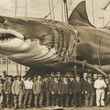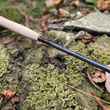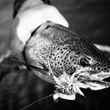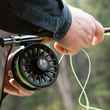I’ve known about Mystic fly rods for a while now—several years. Designer and entrepreneur Dennis Klein and his wife, Victoria, who owns the business, make some fine fishing gear from the company’s small shop in Michigan. If you haven’t heard of Mystic, you need to.
First, Mystic rods are American-made in Portland, Mich., and have been for over a decade. The first Mystic rod I was lucky enough to fish was the company’s 8-weight M-series freshwater rod. Dennis was kind enough to send one to use for a Trout Unlimited carp tournament several years back, and I really fell in love with it.
But what I like most about Mystic is the honesty behind the products. Dennis has been building rods for years, and he’s not afraid to experiment and then seek input on the finished product. I remember, at the Denver Fly Fishing Show a few years back, he eagerly put a rod in my hands for me to cast. When I reported back, he was full of questions for me. How did it cast? Was it fast enough? Too fast? How was the balance? Is it too heavy?
I tried to be as honest as I could, and he took the criticism to heart. He uses that feedback to make his products better. And, honestly, they’re pretty damned good to start with, so Dennis is drilling down on the fine points at this juncture in his career.
Last summer, Dennis sent me his new Reaper four-piece, seven-foot 3-weight, to use on grayling as I drove north through British Columbia, the Yukon and the Alaska. And, as is typical for me and Mystic gear, I loved it.
Mystic bills the Reaper as a true tip-flex fast rod, and it is that, even in four pieces and in the 3-weight version. It comes in sizes all the way to a 9-foot 12-weight, and promises to be just as fast in all versions.
What works
Light and compact
I’ll be honest, I was skeptical of the four-piece design of the light-weight rod—I figured it would add weight, reduce dependability and likely slow the rod down. The latter might be a bit true, but it’s still plenty fast, and it is delightfully light in hand. That it breaks into four pieces makes this a true backcountry pack rod—when in its case, the whole thing is less than two feet long.
It’s a dry-fly rod… with backbone
I had a blast on grayling and small-stream rainbows throughout B.C. and the Yukon casting dry flies with the small Reaper. It was fast enough to handle some bigger water than I might normally have fished with a 3-weight, and it has some serious backbone. As I noted in Hatch earlier this year, I landed a 30-inch pike on the Reaper in an act of desperation—as Donald Rumsfeld might say, “You fish with the rod you have, not with the rod you hope you have.”
Classy guy, that Rumsfeld.
The odd juxtaposition of me casting big streamers to toothy pike with a four-piece 3-weight aside, the results are proof that the little rod packs plenty of backbone. In addition to that one “out of the box” endeavor, the Reaper handled dozens of grayling, some pushing 20 inches and finning in fast water. At its core, however, the Reaper is a dry-fly rod, as you would expect a 7-foot 3-weight to be. And it’s a good dry-fly rod, at that. It’s a pleasure to cast with enough juice to punch through a bit of wind, but not too much as to hinder important presentations.
What doesn’t
Four-piece design
As I noted, the four-piece design is both a blessing and curse if you like fast-action fly rods. For most of us, though, a supple 3-weight is the ideal backcountry implement, so while the four-piece layout does, indeed, slow the rod down a bit, the loss of action is more than made up for by the convenience of being able to lash a small rod tube to your pack on a hike to a hidden trout—or grayling—stream. Plus, a dry-fly rod should be a little slower.
No frills
You’ll notice, too, that the Reaper’s design is very basic. Nothing fancy—no froofy stuff. I suspect that was done to keep the rod light in the four-piece model. It is basic, though. It’s not that it’s not appealing. It’s just clear that cosmetics weren’t atop the list of Mystic’s priorities when this rod was constructed.
Final word
I suppose it’s no secret that I’m something of a Mystic homer. I like rods made by people I know in places situated right here in the good, old USofA. And I like Dennis and Victoria—they’re real people who fish. I’ve watched Mystic evolve over the last decade or so, and I’m almost always impressed by the equipment they produce.
The 3-weight Reaper is a great little trout rod that I was fortunate enough to use to chase grayling all over the North Country last summer. This year, I intend to put it to good use on invasive Yellowstone brook trout and wild, backcountry cutthroats.































Comments